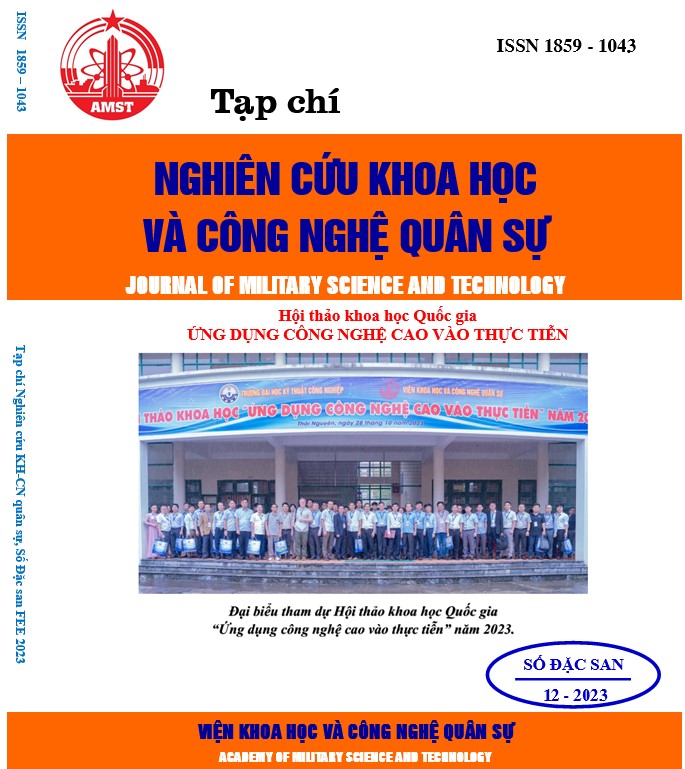The lateral dynamics control of autonomous vehicles using the sliding mode controller combined with an extended state observer
804 viewsDOI:
https://doi.org/10.54939/1859-1043.j.mst.FEE.2023.13-20Keywords:
Autonomous vehicles; Lateral dynamics; State observer; Constant Rate Reaching Law.Abstract
The article presents the ability to control the lateral dynamics of autonomous vehicles under the influence of model parameter variations and environmental effects using Sliding Mode Control (SMC) combined with Extended State Observer (ESO). The dynamic model of the vehicle is constructed considering uncertain disturbances and external environmental influences. Furthermore, by employing model order reduction, both the fast and slow dynamics of the object are delineated. Based on this, the control strategy consists of two parts: firstly, controlling the lateral position of the object, and secondly, steering angle control based on the deviation of the rotational state angle. This study introduces an ESO observation unit coupled with SMC, employing the Constant Rate Reaching Law to observe noise values, ensuring sustainability, and reducing Chattering phenomena. Lyapunov and Hurwitz stability criteria are applied to demonstrate the local and global stability of the control system when integrated with the observer. Finally, the Matlab/Simulink software is utilized for simulation and verification, demonstrating the sustainability, effectiveness, and feasibility of the proposed system.
References
[1]. Y. Tian và các cộng sự, “Control Strategies on Path Tracking for Autonomous Vehicle: State of the Art and Future Challenges”, IEEE Access, (2020), DOI 10.1109/ACCESS.2020.3020075.
[2]. A. Norouzi, M. Masoumi, A. Barari và S. Farrokhpour Sani, ‘‘Lateral control of an autonomous vehicle using integrated backstepping and sliding mode controller’’, Proc. Inst. Mech. Eng., K, J. Multi-Body Dyn., vol. 233, no. 1, pp. 141–151, (2019). DOI: https://doi.org/10.1177/1464419318797051
[3]. Q. Liu, Y. Liu, C. Liu, B. Chen, W. Zhang, L. Li, and X. Ji, ‘‘Hierarchical lateral control scheme for autonomous vehicle with uneven time delays induced by vision sensors,’’ Sensors, vol. 18, no. 8, p. 2544, (2018). DOI: https://doi.org/10.3390/s18082544
[4]. R. Marino, S. Scalzi, and M. Netto, ‘‘Nested PID steering control for lane keeping in autonomous vehicles,’’ Control Eng. Pract., vol. 19, no. 12, pp. 1459–1467, (2011). DOI: https://doi.org/10.1016/j.conengprac.2011.08.005
[5]. D.-C. Liaw and W.-C. Chung, ‘‘A feedback linearization design for the control of vehicle’s lateral dynamics,’’ Nonlinear Dyn., vol. 52, no. 4, pp. 313–329, (2008). DOI: https://doi.org/10.1007/s11071-007-9280-8
[6]. C. M. Kang, W. Kim, and C. C. Chung, ‘‘Observer-based backstepping control method using reduced lateral dynamics for autonomous lanekeeping system,’’ ISA Trans., vol. 83, pp. 214–226, (2018). DOI: https://doi.org/10.1016/j.isatra.2018.09.016
[7]. K. Xu, X. Wu, M. Ma, and Y. Zhang, ‘‘Energy-based output feedback control of the underactuated 2DTORA system with saturated inputs,’’ Trans. Inst. Meas. Control, vol. 42, no. 14, pp. 2822–2829, (2020). DOI: https://doi.org/10.1177/0142331220933475
[8]. H. T. Nguyen, M. T. Nguyen, T. T. Doan, and C. P. Vo, ‘‘Designing PIDfuzzy controller for pendubot system,’’ Robotica Manage., vol. 22, no. 2, pp. 21–27, (2017).
[9]. D. H. Vu, S. Huang, and T. D. Tran, ‘‘Hierarchical robust fuzzy sliding mode control for a class of simo under-actuated systems with mismatched uncertainties,’’ Telkomnika, vol. 17, no. 6, pp. 3027–3043, (2019). DOI: https://doi.org/10.12928/telkomnika.v17i6.13176
[10]. J.Liu, X.Wang, “Advanced sliding mode control”, Springer Berlin Heidelberg, pp. 174-177, (2011). DOI: https://doi.org/10.1007/978-3-642-20907-9_3
[11]. A. Norouzi và các cộng sự, “Vehicle lateral control in the presence of uncertainty for lane change maneuver using adaptive sliding mode control with fuzzy boundary layer”, Sagepub, (2017), DOI 10.1177/0959651817733222. DOI: https://doi.org/10.1177/0959651817733222
[12]. R.Rajamani, “Vehicle dynamics and control”, Springer Science & Business Media, pp. 27-32, (2011).







